
With a deep respect for theory and the practice of ancient textile methods, Mykonos weaver Faye Chatzi is creating contemporary fashion in a tiny workshop just steps away from the hot clubs and chic hotels on the rocky Greek isle.
Hand-loomed textiles are her trademark, with all her raw materials generated from her own sheep and even her own silk worms, as was the case a millennium or two before her.
“It heals my soul,” Chatzi says of the craft of weaving. “The very action of running the loom is a kind of meditation as I move from the outer world into my inner self, stitch by stitch, weft by weft. I want only good energy to flow out of me and into what I create.”
Weaving is most likely the oldest craft tradition known to humankind. Archaeological evidence indicates that weaving has been around for at least 20,000 years. Weaving materials to create fencing, nets, sandals, baskets, and textiles has been part of our human heritage for many hundreds of generations.
“I was given a shawl that had been made in Mykonos on a loom. I had never seen anything like it and became mesmerized,” said Chatzi as she described her first awakening to the world of weaving. “I was so impressed by the pattern, the colors, the texture. I had never seen a loom and knew nothing about handwoven textiles.”
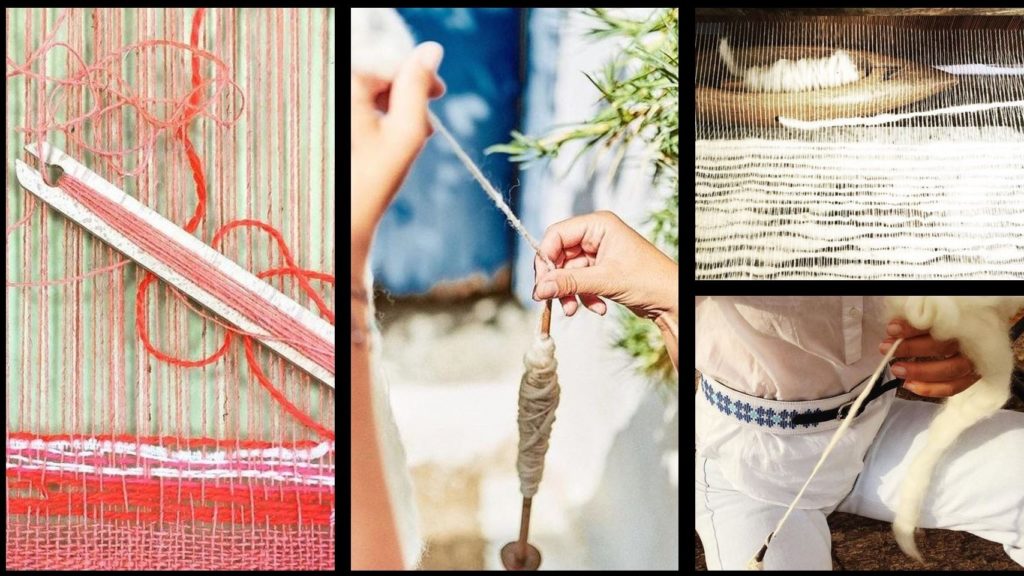
Chatzi said that she sees the loom as a creative toy and is inspired to “play,” much like a young child. Taking patterns and designs she has imagined in her head, she begins the logistical “play” of weaving to make them real.
“There is a holistic energy I absorb as I weave, a joy that energizes each movement, each action,” she tells Greek Reporter.
Even braiding hair, of course, is a form of weaving. The simple act of weaving—going over and under the weft, the taut background strung on a loom—can be a deeply meditative and satisfying process, producing a state of flow and a respite from the busyness of our days.
Weaving is so deeply engrained in our collective psyches that this craft is featured in many cultural origin myths all around the world.
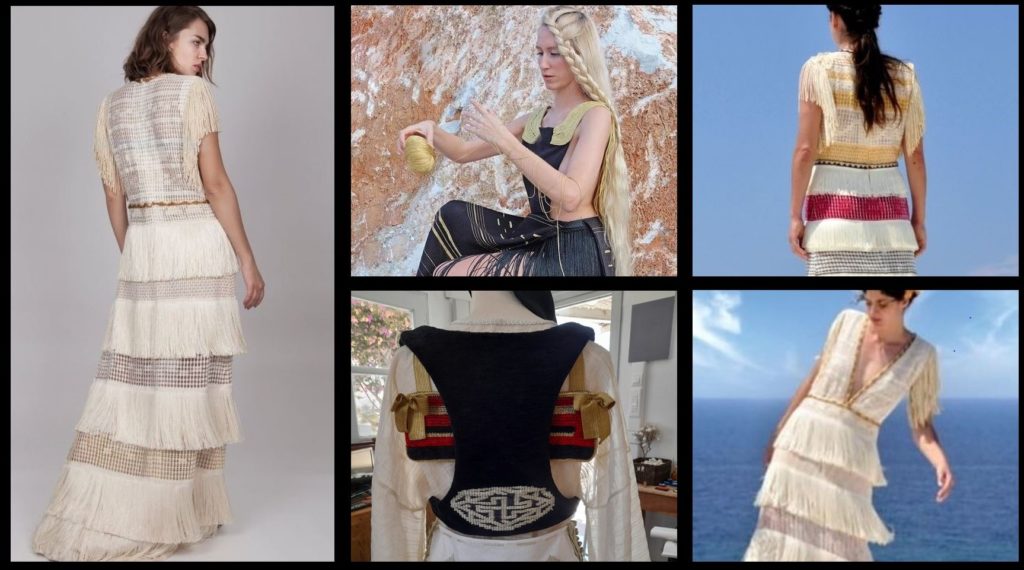
In most places in the world the quality of fabric in a person’s clothes often indicates wealth and identity.
The production of textiles has drastically changed over time, of course, with the mechanized loom and the industrial revolution. Indeed, looms were among the very first human tools to be mechanized during the Industrial Revolution, completely upending the craft as the world had always known it.
But the simple act of traditional weaving by hand remains a powerfully calming process. Slow crafting, producing a piece of fabric row by row, conveys the deeper meaning of all handmade things.
Textile production, even in its ancient form, was a detailed technical process. In weaving, weft and warp refer to the two sets of thread that are woven together to produce fabric. The weft refers to the threads that run horizontally on the loom and get woven in front of and behind the warp. The warp refers to the strong threads that are strung vertically on the loom.
Mykonos Weaver a Self-Taught Crafter
Chatzis landed on Mykonos more than two decades ago. Her initiation to the idyllic Greek island was a summer job as a waitress at a waterfront cafe. She liked Mykonos and stayed, finding work as a guard for many years on the island of Delos.
Delos is a designated UNESCO Heritage site, the largest archaeological site in Europe, with ancient structures and sculptures dating back to a time when Greeks worshipped their mythical gods.
She eventually fell in love with a local man and that was when she really began setting roots on the island. Her interest in local customs and culture was always high and she was fascinated with looms. A elderly Mykonian woman, Evangelia Kami, a treasure trove of local custom and culture, offered Chatzi her old loom, which was sitting unused in storage.
And so Chatzi began her fascinating journey into the warp and the weft of textile production. The loom was in disrepair, but with love and respect for authenticity, she brought the tool back to functional life.
She spent time with veteran weavers on the island to learn the many intricacies of the loom. Many of those women had learned the craft even before they had begun first grade. Generations of weaving knowledge was shared as Chatzi began her own experimentation with the ancient craft.
Almost all of her free time was now dedicated to the loom and as she thirsted for further knowledge she found resources through museums and exhibitions.
As she began to consider the full cycle of weaving, from the source of the threads and yarns to the finished product, Chatzi realized she had the means to create products from beginning to end. Her former partner’s family has their own livestock.
When it came time to shear the lambs in the spring, so they could keep cool as they grazed in open fields in the intense heat of summer, she was appalled that the fleece was simply being discarded.
The artisan quickly learned what was required to treat the fleece and prepare it to be spun into wool. Today she uses the fleece sheared from lambs, not adult sheep, since it is softer in texture.
And treating the fleece begins right at the source, in the most natural of ways, surely just as it was done in times of old She leads the lambs literally into the Aegean and rubs them down in the sea, removing bits of dried hay, grass, nettles and manure. The lambs lap up the sun following their sea bath, so the fleece dries quickly. The lambs are then sheared and Chatzi gathers the wool to be prepared.
The fleece is treated by being bathed again, dried and then combed to remove any remaining bits that did not loosen in the sea. Poised between agile fingertips, the wool is then spun into a thread or yarn, to eventually be used as weft, woven in and under the warp, in the loom.
The process is intensely physical, requiring plenty of hours and hands on labor.
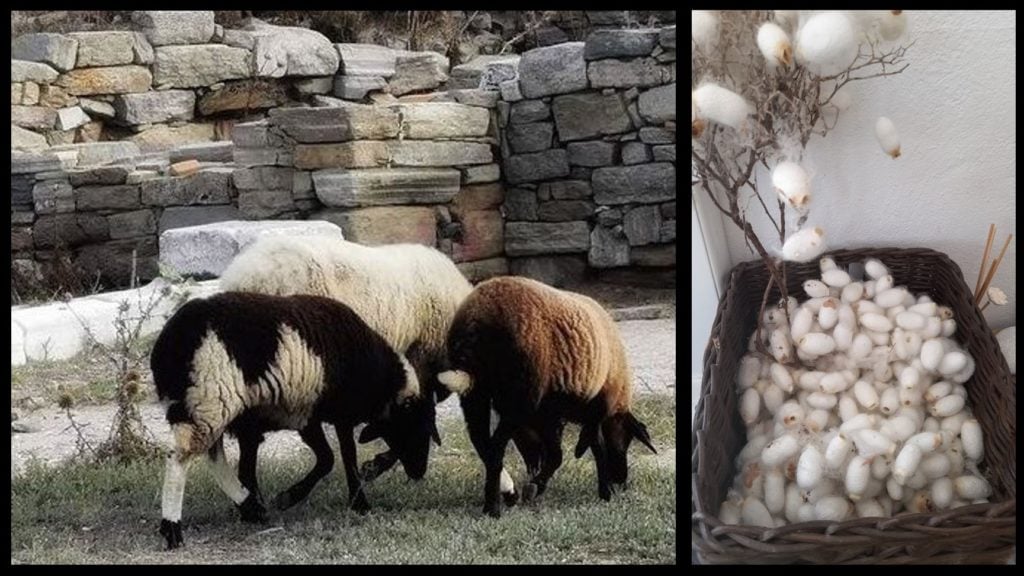
Silk Worms Adopted for Zero Waste
“I take the materials from the beginning of the process, nurturing and cultivating them, as if they were being born through me,” Chatzi said of the intense steps needed in the weaving process.
And she hasn’t stopped at lamb’s wool. She even uses silk, the ultimate in luxurious fibers, in her work as well after investigating how to use silkworms to produce fibers. A visit to the Agricultural School in Athens initiated her into the esoteric world of silk worm cultivation.
As silk worm cultivation was a part of the curriculum of the school’s students, there were ample cocoons to be given up for adoption after the course—which may otherwise have, incredibly, become fish bait. Chatzi, who is both a vegan and a naturalist, naturally chose to add a few members to her family rather than feeding them to the fish.
The weaver told Greek Reporter “Initially I kept them in my kitchen. At night when it was quiet you could hear the soft crunching as they produced the silk. It really made me feel at one with the process.”
One single silk worm is able to produce an incredible 5000 to 10,000 feet of silk, with each strand as thin as hair. Chatzi explains that she uses six or more strands together to make them viable. When the worms come to the end of their lifecycle, she does not make them fish bait, but instead allows them to morph naturally.
Silkworms, which are soft-bodied and slow moving, can grow to three inches in length. They are also relatively fast growing, reaching those three inches and becoming ready to cocoon in as little as 28 days on a daily diet of leaves. Silkworms go through four stages of development, as do most insects: egg, larva, pupa and adult.
The pupa is what the silkworm changes into after spinning its cocoon, before emerging as a moth. Since the silkworm grows so much, it must shed its skin four times while it is growing.
Chatzi’s “family” had soon expanded from her son to several lambs as well as a few hundred cocoons of silk worms. And her interest in weaving expanded apace.
Her new vocation morphed into an occupation when she headed into Mykonos town and set up shop in small space, nestled within the labyrinth of its small streets. While in town, she received many bravos for her work but not much traffic to generate sales.
Dissatisfied, she moved her workshop and retail space to one of the main roads leading out of town to the beaches. Her home, located just around the corner, made it more convenient for her as the working mother of a little boy, who will start fifth grade this fall.
A second functional loom is in her home in Athens. She stays on Mykonos during the summer but the school year is spent in Athens, for the benefit of her young son.
The Mykonos weaver works on consignment with various establishments. She also tends to stick with the classic colors of black and white in her color schemes. However, in a departure from the monochromatic scheme, one of her most recent designs, “Manto,” pays homage to the Mykonian heroin who was instrumental in the Greek revolution of 1821.
The colors used here are black, red, gold and white. When Chatzi does want color in her threads, she uses only natural dying methods. Avocado is one of her favorite dye ingredients of choice. She adheres to a lifestyle of zero waste.
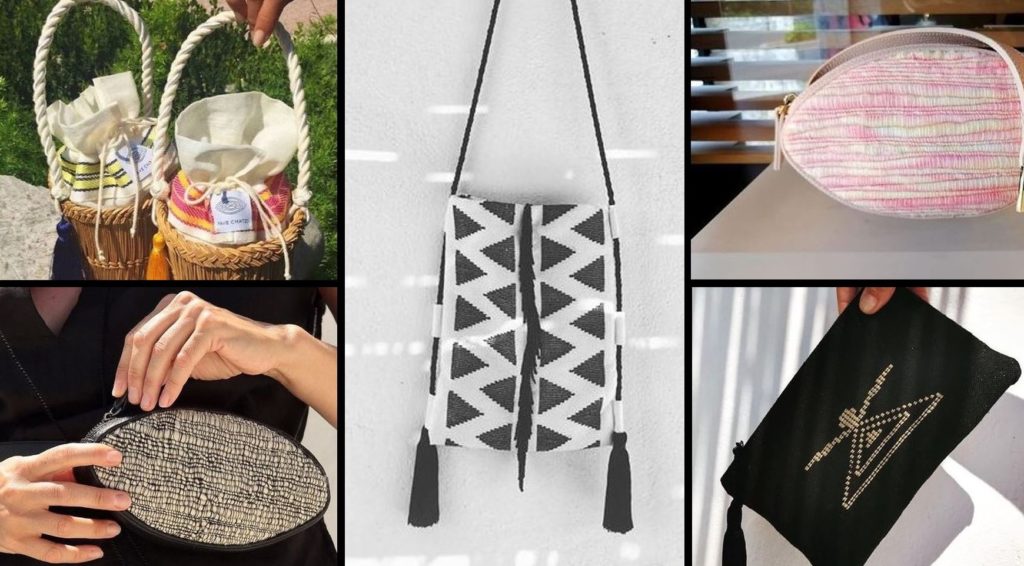
Delos, Greek History, Mythology Inspire Designs
Chatzi’s time serving as a guard on Delos was certainly a source for her inspiration. Steeped in the mythology of the ancient Greek gods, with so many temples and sculptures dedicated to the deities, no doubt it was inspiration by immersion.
One of Chatzi’s most recent designs is a little black bag with a triangular symbol. That too, is of mythical inspiration. The Delian tanit is lifted directly from the mosaic floor of one of the courtyards from the “House of the Dolphins” behind the ancient theater.
And in tribute to the first weaver, according to Greek mythology, Arachne, Chatzi has baptized one of her designs dedicated to the myth of weaving and the loom.
According to this myth, a beautiful maiden named Arachne was the daughter of a craftsman. She came from humble beginnings, and learning from her father, she developed an incredible talent for weaving.
She created beautiful tapestries. As she weaved, it was as though the thread came from the very tips of her fingers. People would come from far and wide to watch Arachne at work because it was mesmerizing. Arachne, however, was not so humble herself, and this was a trait that eventually led to her demise.
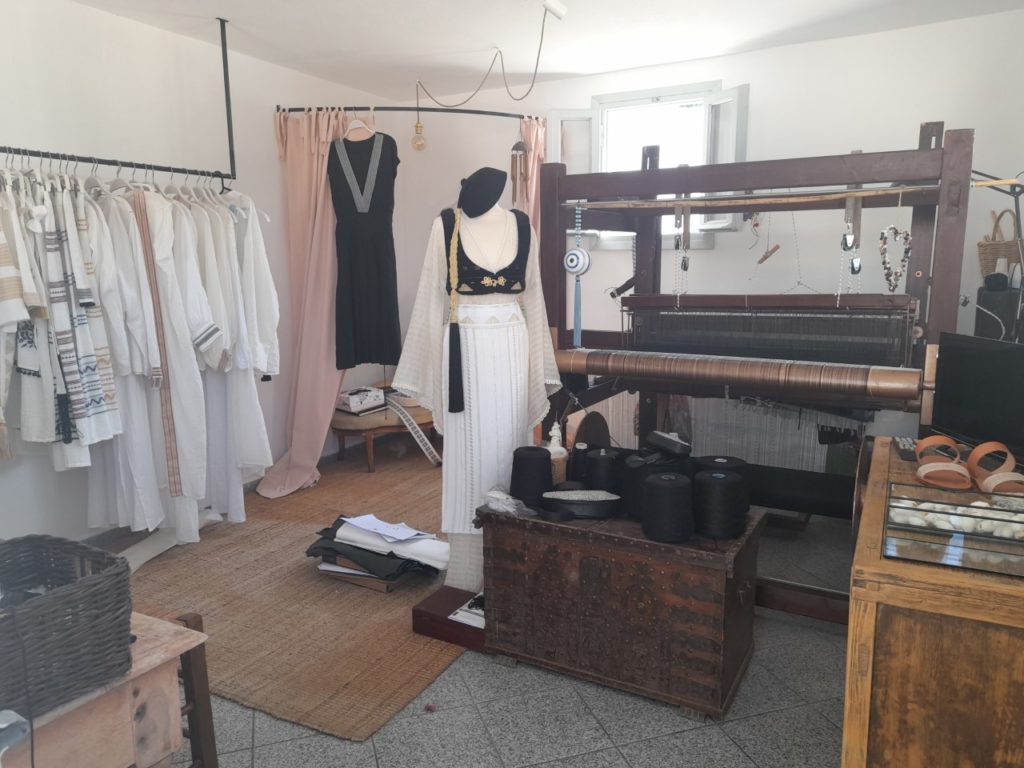
The bigger her audiences became, the more she would boast. In ancient times it was assumed, especially regarding a gift as incredible as Arachne’s, that these were passed down by the gods. So, the fact that she denied the origin of her talent was an astonishing betrayal of them.
It wasn’t long before the rumors of Arachne’s arrogance reached the goddess Athena, who was a fine weaver herself.
The goddesses had a love of disguising themselves as harmless old women. Being disguised as an elderly and unassuming old lady was one of the easiest ways to take advantage of mortals. And unfortunately, this is exactly what happened to Arachne.
Upon hearing Arachne’s claims, Athena, disguised as an old woman, approached her. Thinking she was merely talking to someone insignificant, Arachne boasted once again of her ability and said she would easily challenge the goddess herself if she could. Athena then revealed herself to the young maiden.
A weaving contest ensued. Athena created a tapestry of all the Greek gods on Mount Olympus, woven from the very fabric of the earth, as only a goddess could. Threads of clouds and blades of grass made for the most stunning of pieces of work. It represented the gods in all their spectacular power and glory.
Arachne’s depiction, however, was much different. While still intricate and breathtakingly beautiful, she depicted the gods at their worst, as drunk and disorderly and abusing their power as some of the worst Greek gods often did.
Athena was horrified by this blatant mockery of the Olympian gods. Other than the blasphemous depictions, however, she could find not a single fault. This extraordinary yet offensive work of art was all too much for Athena to handle, and she exploded into a violent rage.
Turning to Arachne, she inflicted her punishment on her. Arachne began to sprout legs, one after the other. She grew more eyes until she had eight and eventually Arachne was no longer a beautiful maiden. Athena had turned her into the very first spider. To this day, her many descendants all over the world continue to weave delicate and intricate works of art of a different kind.
In considering the journey her own life has taken, from waitress to weaver, Chatzi told Greek Reporter that she would not change a thing. “It is only through our darkness that we can find our light,” she said. “Without having stumbled and experimented, how would I have found my way to this beautiful part of my journey?”
The weaver added “I wouldn’t like to change the past or the future, but I do have the chance to change the present, moment by moment with the choices I make.”
Let’s hope Chatzi continues to choose to make exquisite products from her loom, continuing the ancient traditions of Greece into the future.
See all the latest news from Greece and the world at Greekreporter.com. Contact our newsroom to report an update or send your story, photos and videos. Follow GR on Google News and subscribe here to our daily email!



